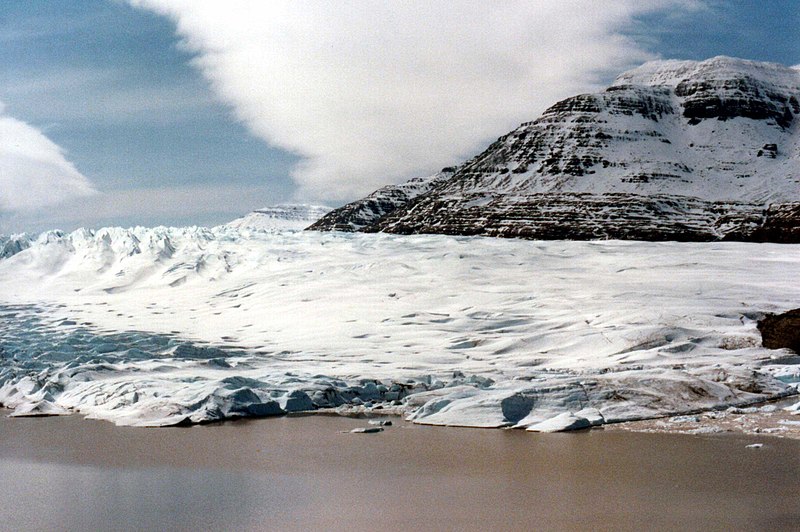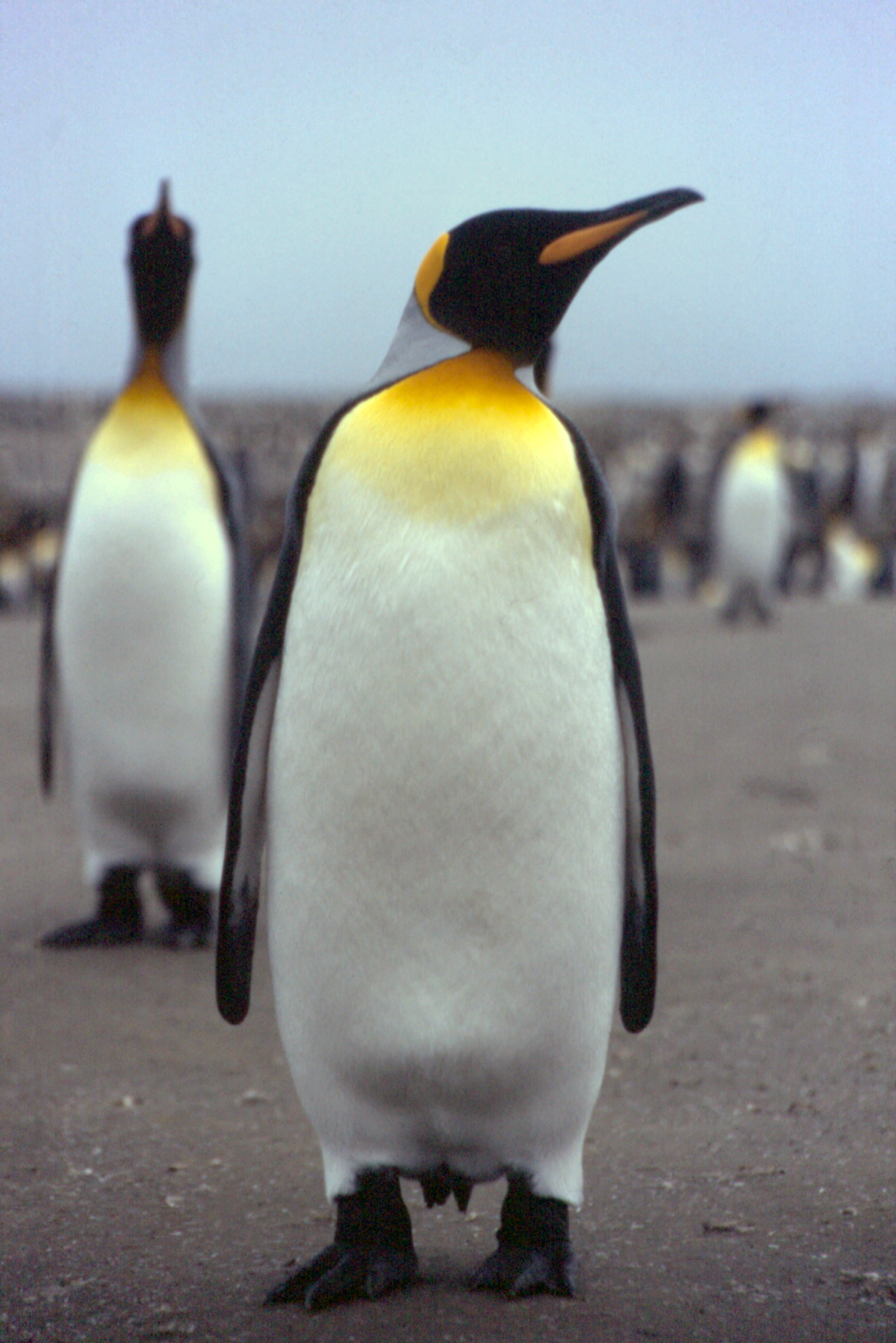
Cook Glacier, southern rim, Kerguelen Islands: photo by B. navez, 1983; image by Thermadchopper, 2005
We proceeded to Kerguelen’s Land, and after twice being blown off in a gale we at last, on May 12, anchored in Christmas Harbour. During the passage there were few sea-animals, so I studied Cape plants with Harvey, Endlicher, and De Candolle.
From a distance the Island looks like terraces of black rocks; on which the snow lies, causing it to look striped in horizontal bands. On the melting of the snow, the flats appear covered with green grass and the hills with brown and yellow tufts of vegetation. The shores are almost everywhere bounded by high, steep precipices, some of frightful height, above which the land rises in ledges to the tops of the hills. The varied colour in the vegetation gave me hopes that the country might be rich in mosses, &c., nor could anything the ingenious Mr. Anderson in ‘Cook’s Voyages' said persuade me to the contrary. . . . Surely, I thought, this cannot be such a land of desolation as Cook has painted it, containing only eighteen species of plants.
Christmas Harbour is well described and figured by Cook, indeed the accuracy with which he made a running survey of the coast is quite marvellous, and shows how talented a man he was. I cannot say so much of his Surgeon and Botanist, ‘The ingenious Mr. Anderson,’ as our copy calls him. Had Cook been here in winter he would have found it a different place to lie in from what it is in summer; the winds blow into it from the N.W. with the most incredible fury, preventing sometimes for days any intercourse with the shore. We have the chain cables of a 28-gun ship, and yet we drove with 3 anchors and 150 fathoms of chain on the best-bower, 60 on the small, and a third anchor under foot, the Sheet. Such a thing was never heard of before!
During our stay I devoted all my time to collect everything in the botanical way, and I hope you will not be disappointed with the fruits of my poor exertions. You say you hope I shall double the Flora and I have done so. I was much surprised at finding the plants in a good state of flower and fruit (all but two).
My time was my own to leave the ship when I liked, for the Captain took off all restrictions to my going where I liked. My rambles were generally solitary, through the wildest country I ever saw. The hill tops are always covered with snow and frost, and many of my best little Lichens were gathered by hammering out the tufts or sitting on them till they thawed. The days were so short and the country so high, snowy, and bad that I never could get far from the harbour, though I several times tried by starting before light. As far as I went the vegetation did not differ from that of the bays. . . .
I went several boating excursions in the neighbourhood, and in one was dismasted and nearly swamped. So Captain Ross would send no more, and I am promised to be of a longer and better party on the next opportunity. Two Lycopodia, one splendid one, and a Fern were all Mr. McCormick added to my collection. He brought numerous splendid quartz crystals and zeolites, &c., together with lots of coal and fossil wood. The latter we had long before found, and I first detected it lying in immense trunks in the solid basaltic rock; its existence here is wonderful in the extreme; I have plenty of specimens.
In the absence of trees, the coloured patches of Lichens on the hillsides, the heaving belt of seaweed girdling the shores, took the place of forest green or autumnal tints.
The Lichens appear here to form a greater comparative portion of the vegetable world than in any other portion of the globe, especially when it is considered that from the want of large trees there can be no parasitical species. The rocks from the water’s edge to the summit of the hills are apparently painted with them, their fronds adhering so closely to the stone that they are with difficulty detached; in other cases they seem to form part of the rock which, from its excessive toughness and hardness, almost defies any attempt to procure specimens that can be satisfactory. But it is at the tops of the hills that they assume the appearance of a miniature forest on the flat rocks, and nothing can be prettier than the large species with broad black apothecia that covers all the stones at an elevation of from 1000-1500 feet. A smaller species like a little oak-tree grows in spreading tufts also upon stones, and is of a delicate lilac color. Near the sea they are generally more coriaceous, especially a yellow one that then forms bright yellow patches on the cliffs. In the caves, also near the sea, a light red one is so abundant as to tinge such situations with that color, and many other species inhabit the rocks and their crevices.
Le Volcan du Diable, Kerguelen Islands: photo by B. navez, February 1984/2006
Seaweeds are in immense profusion, especially two large species, the Macrocystis pyriferal and the Laminaria radiata; the former of these forms a broad green belt to the whole Island (as far as seen) of 8-20 yds. across within 20 feet or so from the shore. Here its branches are so entangled that it is sometimes impossible to pull a boat through it, and should any accident occur outside of it, its presence would prove an insurmountable obstacle to the best swimmers reaching land. On the beach the effect of the surf beating it up and down is very pretty, but not so striking as the view from a little elevation, of a bay, with this olive green band running round it. The sea birds, etc., when on the water, always fly over or dive under to reappear on its other side. The Laminaria hangs down from every rock within reach of the tide, perpetually in motion from the lashing of the surf, and yet from its shininess and strength always unhurt. I think I may safely affirm that no other species in the vegetable kingdom has so secure a rooting as this seaweed has on the bare rock. I have often sat upon the cliff overhanging the sea at the N.W. bay during a gale of wind, and watched the surf break with terrific violence on the rocks, which are often themselves detached and alternately brought backwards and forwards by the swell and reflux with a deafening roar; still the coriaceous fronds of this weed are with impunity washed backwards and forwards, then form attachments defying the power of the sea. . . . The only use in Nature I can assign to it is the shelter it affords to a species of Patella from the attacks of the gulls, which prowl about during low water and secure as their prey any other unfortunate shellfish which is exposed. The weight of the fronds of the Laminaria hanging down over the dry rocks forms an insurmountable obstacle to the birds.
Bec-en-fourreau /Black-faced Sheathbill, aka Lesser Sheathbill, or Paddy (Chionis minor), Kerguelen Islands: photo by B. navez, 1983/2005
The birds, unused to man, were devoid of fear. In the shallow bay next to the Arch Point, were myriads of the beautiful Sheathbill as the sailors called it (a Chionis), so tame that it allows you to come quite close to it. It was something like a pigeon, black legs (not webbed), beak and eyes; it ran with great agility among the rocks, like ptarmigan, helping itself by the first joint of the wings, which is provided with two callous extremities admirably adapted for this purpose, and came close to examine me; its plumage is of a spotless white, with a slight pink tinge on the primaries of the wings; the bill was a sheath common to the two nostrils. On one occasion I thoughtfully sat down on a stone and commenced whistling a tune when, on turning my head, I found I had unwittingly been performing an Orpheus’s part, for upwards of twenty of these beautiful birds had gathered about me, and were gradually approaching, declining their heads and narrowly watching my motions, and would even perch on my foot, rocking their heads on one side in the most interesting manner. Among them were some penguins, peering over the rocks . . . so tame that they allowed me to take them by the beaks.
King Penguins (Aptenoydes patagonicus), Feu de Joie beach, west coast, Kerguelen Island: photo by Dimitri Damasceno, 22 September 2004
Cook Glacier, southern rim, Mt. Cook, seen from the Gulf of Morbihan, Kerguelen Islands: photo by B. navez, 1983/2005







No comments:
Post a Comment